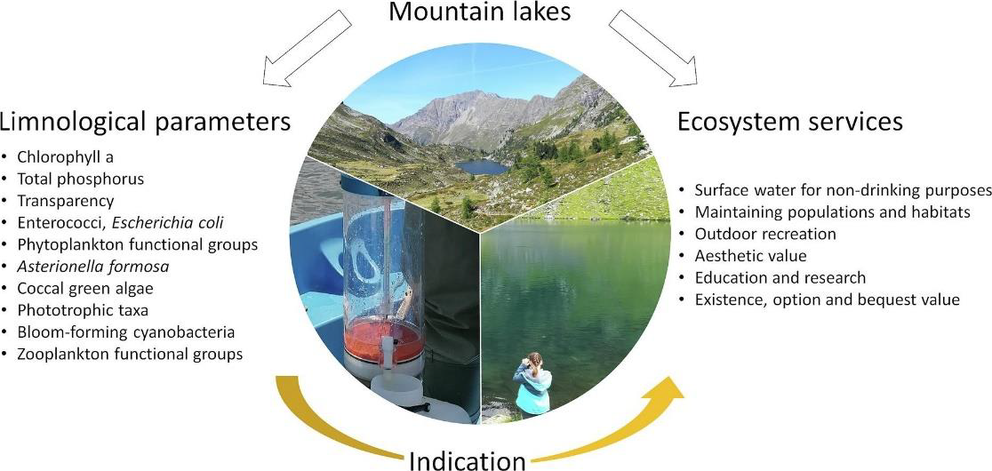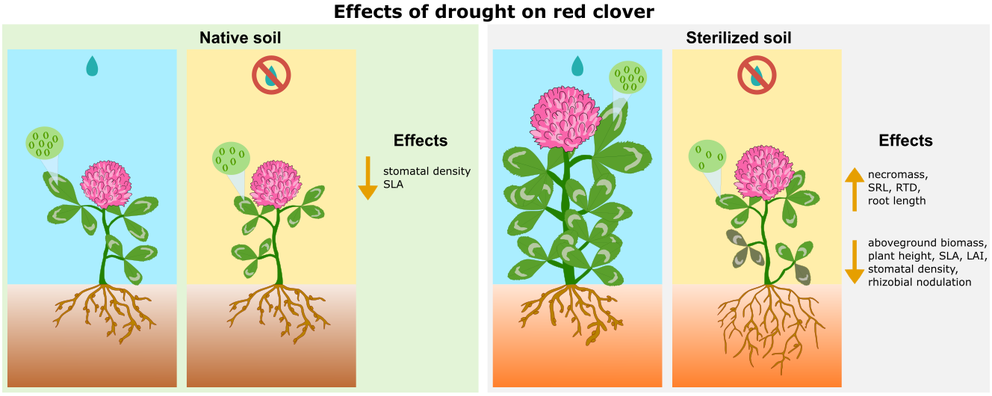Student Paper Awards 2023
The Student Paper Awards 2023 have been awarded to Hanna Pritsch and Elena Tello García. Congratulations to both!
Below a description of the awarded papers.
Plankton community composition in mountain lakes and consequences for ecosystem services
Mountain lakes play a crucial role in providing a variety of ecosystem services (ES), including water provision, habitat maintenance, outdoor recreation, aesthetics, education and research, and more. However, these pristine ecosystems are vulnerable to the impacts of global change, including factors like global warming, intensified land use, and increased human activities such as fish stocking, tourism, and livestock farming. Ensuring the continued provision of these ES relies on maintaining the integrity of these ecosystems. To develop targeted conservation measures, it is imperative to monitor changes in the ES of mountain lakes, necessitating the use of suitable indicators.
While previous assessments have mainly focused on aesthetic and recreational values using transparency as an indicator, this study takes a more comprehensive approach, by investigating the link between limnological parameters and potential ES provision employing widely used standard parameters and metabarcoding based on 16S/18S rDNA high-throughput sequencing to obtain information on plankton communities.
In this study we sampled 26 mountain lakes in the European Alps and related ten limnological parameters to six ES identified as most relevant by local stakeholders. Results indicated generally low to moderate concentrations of total phosphorus and chlorophyll a, along with high transparencies, classifying most lakes as ultra- (n=6) or oligotrophic (n=18). Phytoplankton functional groups aligned with the trophic state, revealing insights such as a decrease in the relative abundance of mixotrophic versus phototrophic phytoplankton with increasing trophic state. While most lakes showed high potential for providing multiple ES, only six lakes supported larger cladocerans, suggesting an overall reduced food availability for amphibians. The high transparency of most lakes indicated a high potential for aesthetic and recreational values, while some lakes with a greater proportion (>30%) of phototrophic phytoplankton manifested reduced water clarity, probably due to eutrophication.
Our findings highlighted that ecological deterioration in these lakes could negatively impact the future provision of ES, underscoring the urgency of conservation measures in the face of global change. The study emphasized the importance of protecting pristine mountain lakes. Notably, data on plankton community composition could serve as valuable guidance for prioritizing lakes for protection efforts.

Graphical abstract showing the link between mountain lake ecosystems, assessed by limnological parameters, and provided ecosystem services.
Pritsch, H., Schirpke, U., Jersabek, C. D., & Kurmayer, R. (2023). Plankton community composition in mountain lakes and consequences for ecosystem services. Ecological Indicators, 154, 110532. https://doi.org/10.1016/j.ecolind.2023.110532
Red clover productivity under drought: Are soil microbes a burden or a treasure?
Plants face water scarcity by changing their traits to avoid water loss by reducing leaf size, increasing leaf thickness and reducing stomatal density, and to increase root uptake by increasing root biomass. While these responses to drought are well documented, the role of plant-soil interactions in influencing these changes remains unclear. This study focuses on mutualistic soil microbes, specifically arbuscular mycorrhizal fungi (AMF) and Rhizobium, which are known to enhance plant productivity, water and nutrient uptake, and stress tolerance. We hypothesise that fluctuations in soil microbial populations not only influence plant productivity, but also modulate plant responses to drought by shaping plant traits. To test this hypothesis, a pot experiment was conducted with red clover (Trifolium pratense L.). The experiment included two treatments: a water treatment (wet versus drought) and microbial reduction by soil steam sterilization (native versus sterilized soil).
The results showed that plants in the native soil had low productivity and exhibited traits associated with slow-growing strategies, including smaller and coarser leaves, lower stomatal density, and increased root mass. Mutualism with beneficial microbes, such as AMF, and the fight against pathogens required resources from the plant, hindering productivity. Conversely, reducing soil microbial loads through sterilization increased plant productivity under well-watered conditions, promoting traits associated with fast-growing strategies. However, under drought conditions in sterilized soil, productivity decreased, early wilting occurred, and traits associated with a slow-growing strategy emerged. Notably, roots became longer and thinner and rhizobial nodulation decreased, signalling a reduction in mutualistic interactions.
These findings highlight the key role of soil microbes in triggering changes in plant traits, and thus their importance in plant responses to drought. Additionally, they highlight the microbial contribution to maintaining plant productivity and vitality of red clover under challenging environmental conditions.

Graphical abstract of the paper showing the effects of drought on red clover growing in native soil and sterilized soil.
Tello-García, E., Mandolini, E., Tasser, E., Probst, M., Peintner, U., Tappeiner, U., Leitinger, G. (2023) Red clover productivity under drought: Are soil microbes a burden or a treasure?
Environmental and Experimental Botany 214: 105486 DOI: https://doi.org/10.1016/j.envexpbot.2023.105486
Student paper awards 2022
Previous Science Flash contributions:
Red clover productivity under drought: Are soil microbes a burden or a treasure?
DP ABGC Student Paper Award 2021
DP ABGC Student Paper Award 2020
The multifunctionality of mountain landscapes
Pros and cons of using a standard protocol to test germination of Alpine species
Agent-Based Modelling of a Coupled Water Demand and Supply System
Wolbachia megadiversity: 99% of these microorganismic manipulators unknown
DP ABGC Student Paper Awards 2019
The microbiome of plants: R. glacialis and its rhizobiome along a high-alpine altitudinal gradient
Lots of ‘junk’ in the genome of a small aquatic invertebrate
A dataset for future monitoring of climate change effects in Alpine streams
Forest fires: How surviving trees can suffer from heat injuries
Guidelines for Science Flash contributions
Submissions to the Science Flash must include:
- Title (short and attractive for a wider audience)
- Short abstract of your publication as the main body of your contribution, which summarizes the main findings of your study in a way that is also accessible to scientists from other fields and non-scientists.
- 1 figure that will be included in the Science Flash contribution (any size; can also be a composite of more figures). Please include a short figure caption.
- 1 catching figure that will be displayed at the main page (can be your main figure or a part of it; without captions). Please consider that this figure will be displayed as a small image at the main page (above the link to the Science Flash section) and details/text will not be legible due to the small size. This figure must have a size of 1800 x 1080 px (or equivalent ratio), to ensure that the image will be displayed correctly.
- Information about the publication (Authors, year, title, journal, DOI/weblink)
Please submit your contribution as a Word file (Title, body, figure caption) and image files (jpg, png,…) to Michael.Bahn@uibk.ac.at and Gilbert.Neuner@uibk.ac.at
